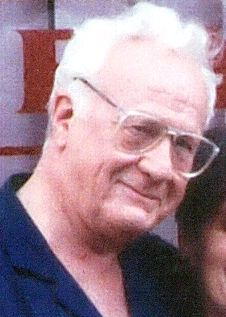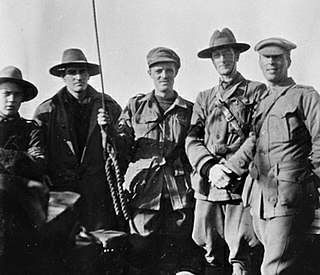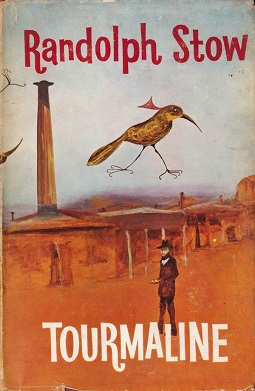Related Research Articles

Ruby Lindsay was an Australian illustrator and painter, sister of Norman Lindsay and Percy Lindsay.

Clifton Ernest Pugh AO, was an Australian artist and three-time winner of Australia's Archibald Prize. One of Australia's most renowned and successful painters, Pugh was strongly influenced by German Expressionism, and was known for his landscapes and portraiture. Important early group exhibitions include The Antipodeans, the exhibition for which Bernard Smith drafted a manifesto in support of Australian figurative painting, an exhibition in which Arthur Boyd, David Boyd, John Brack, Robert Dickerson, John Perceval and Charles Blackman showed; a joint exhibition with Barry Humphries, in which the two responded to Dadaism; and Group of Four at the Victorian Artists Society Gallery with Pugh, John Howley, Don Laycock and Lawrence Daws.

Francis Rossiter Crozier was a war records artist who is represented in the Australian War Memorial's art collection along with other Australian official war artists such as H. Septimus Power, Arthur Streeton, George Washington Lambert and Ivor Hele.

Mirka Madeleine Mora was a French-born Australian visual artist and cultural figure who contributed significantly to the development of Australian contemporary art. Her media included drawing, painting, sculpture and mosaic.

Alethea Mary Proctor was an Australian painter, print maker, designer and teacher who upheld the ideas of 'taste' and 'style'.
Andrew John Sibley was an English-born Australian artist. Sibley has been the subject of three books and is commonly listed in histories and encyclopedias of Australian art as a significant figurative painter of the mid and late 20th century.
Mosman Art Gallery is the main public art gallery for the Mosman area on the north shore of Sydney, New South Wales, Australia.
A Cheery Soul is a 1963 play by Australian writer Patrick White set in the fictional Sydney suburb of Sarsaparilla at the end of the 1950s. White described it as being about "the destructive power of good."

Tourmaline (1963) is the fourth novel by Australian writer Randolph Stow.
The Museum of Modern Art Australia (MOMAA), alternatively named the 'Museum of Modern Art of Australia,' or, according to McCulloch, the 'Museum of Modern Art and Design' (MOMAD), was founded by Australian art patron John Reed in 1958 in Tavistock Place, a lane-way off 376 Flinders Street, Melbourne, launched previously with a survey of Modernist Victorian women artists on 1 June 1956, organised by the Reeds who had taken on the then named Gallery of Contemporary Art. It held exhibitions of important contemporary Australian and international art of the late 1950s and early 1960s. The Museum operated until 1966 and was formally dissolved in 1981.
Toorak Art Gallery was an art gallery 277 Toorak Road, South Yarra, Melbourne, Victoria, which specialised in contemporary figurative and abstract Australian art. It was in operation from 1964 to 1975.
Gallery A was a mid-century Australian gallery that exhibited contemporary Australian art. It was established in 1959 at 60 Flinders Lane, Melbourne, and then relocated to 275 Toorak Road., South Yarra. A second Gallery A venue was opened and run concurrently at 21 Gipps Street, Paddington in Sydney from 1964, and a third in Canberra. The Sydney business largely displaced the Melbourne gallery, which also closed in 1970, and continued until 1983. Its founder was Max Hutchinson and other directors during the history of the gallery at its three venues included Clement Meadmore, James Mollison, Janet Dawson and Ann Lewis.
Velasquez Gallery, also known as Velasquez Gallery at Tye's, and later Tye's Art Gallery, was a Melbourne art gallery that showed contemporary traditional, and later, modernist Australian art, including some sculpture and prints, as well as Australian indigenous art. It operated from 1940 to 1955.

Mary Finnin was an Australian artist, art teacher and poet.

Elizabeth Deans Paterson was an Australian commercial artist, cartoonist and illustrator. She was best known for her pictures of babies and young children.
Sandra Leveson, also known as Sandra Leveson-Meares, is an Australian painter, printmaker, and teacher.
Alexander Colquhoun was a Scottish-born Australian painter, illustrator and art critic.
Rosemary Ryan was a mid to late twentieth-century Australian painter
The Bulletin Reciter : A Collection of Verses for Recitation 1880-1901 (1901) is an anthology of poems by Australian poets originally published in The Bulletin. It was published in hardback by The Bulletin in 1901, and was followed the same year by a similar collection of stories and literary sketches from the magazine.
We Find the Bunyip is a 1955 Australian play by Ray Mathew. It is a comedy set in an Australian country pub.
References
- ↑ "THE ONE ACCESSORY I JUST CAN'T LIVE WITHOUT". The Australian Women's Weekly . Vol. 41, no. 52. Australia. 29 May 1974. p. 41. Retrieved 17 November 2019– via National Library of Australia.
- 1 2 3 4 "MELBOURNE The boom some love to hate (21 September 1974)", The Bulletin, 096 (4924), John Haynes and J.F. Archibald, 21 September 1974, ISSN 0007-4039
- ↑ "ART (5 October 1974)", The Bulletin, 096 (4926), John Haynes and J.F. Archibald, 5 October 1974, ISSN 0007-4039
- ↑ "ART (27 April 1974)", The Bulletin, 096 (4903), John Haynes and J.F. Archibald, 27 April 1974, ISSN 0007-4039
- 1 2 "VIBRANT, VOLATILE ARTIST". The Canberra Times . Vol. 55, no. 16, 598. Australian Capital Territory, Australia. 7 March 1981. p. 17. Retrieved 17 November 2019– via National Library of Australia.
- ↑ "Australian Art Auction Sales - Numbers Offered and Sold". www.aasd.com.au. Retrieved 17 November 2019.
- ↑ Australia, National Museum of (8 June 2011). "Understanding Museums - Art Museums in Australia". nma.gov.au. Retrieved 17 November 2019.
- ↑ Heathcote, Christopher; Kemp, Roger, 1908-1987 (2007), A quest for enlightenment : the art of Roger Kemp, Macmillan, p. 148, ISBN 978-1-876832-43-8
{{citation}}: CS1 maint: multiple names: authors list (link) CS1 maint: numeric names: authors list (link) - ↑ Sibley, Andrew J; Thomas, David, 1937-, (author.); McGregor, Ken, (book producer.) (2004), Andrew Sibley : an epic of the everyman, Macmillan Art, ISBN 978-1-876832-15-5
{{citation}}:|author2=has generic name (help)CS1 maint: multiple names: authors list (link) CS1 maint: numeric names: authors list (link) - 1 2 Harding, Lesley; Morgan, Kendrah, (author.) (2018), Mirka & Georges : a culinary affair (1st ed.), Miegunyah Press, ISBN 978-0-522-87220-0
{{citation}}:|author2=has generic name (help)CS1 maint: multiple names: authors list (link) - ↑ "End of the haul (17 April 1976)", The Bulletin, 098 (5003), John Haynes and J.F. Archibald, 17 April 1976, ISSN 0007-4039
- ↑ Gallery, Toorak Art. [Toorak Art Gallery : Australian Gallery File].
- ↑ "Toorak Art Gallery [1]. (1964 – 1974) · Australian Prints + Printmaking". www.printsandprintmaking.gov.au. Retrieved 3 December 2019.
- ↑ Statham, John (1 October 2009). "Heritage Place – Citation Assessment: Former St Johns Church of England School and Parish Hall" (PDF). Stonnington Council.
- ↑ Latreille, Anne; Latreille, Peter; Lovell, Peter H (1981), New uses for old buildings in Australia, Oxford University Press, p. 52, ISBN 978-0-19-554301-8
- ↑ "MELBOURNE A moveable festival (25 October 1975)", The Bulletin, 097 (4980), John Haynes and J.F. Archibald, 25 October 1975, ISSN 0007-4039
- 1 2 3 Brigid Cole-Adams, 'Art on the grand scale,' in The Age, Tuesday, 15 April 1980, p.21
- ↑ Coate, Bronwyn. "A Comparative Study of Australian Indigenous and Non-Indigenous Art" (PDF).
- ↑ "Catalogue: 'Some Interpretations of Landscape'. Tasmanian School of Art Gallery, University Of Tasmania, Mt. Nelson Campus, Hobart. October 26- November 14, 1981" (PDF). Paul Zika. 1981.
- ↑ Ryan, Judith; Batty, Philip; National Gallery of Victoria (2011), Tjukurrtjanu : origins of Western Desert art, National Gallery of Victoria, ISBN 978-0-7241-0345-4
- ↑ "Clifford Possum art sells for $2.4m record". NewsComAu. 24 July 2007. Retrieved 17 November 2019.
- ↑ Allen, Traudi; Pugh, Clifton, 1924-1990 (1981), Clifton Pugh, patterns of a lifetime : a biography, Nelson, ISBN 978-0-17-005443-0
{{citation}}: CS1 maint: multiple names: authors list (link) CS1 maint: numeric names: authors list (link) - ↑ "Taken at Realities Gallery in Toorak almost seven years after the dismissal, we see Gough Whitlam launching Clifton Pugh's biography "Patterns of a Lifetime" while appearing to be shadowed by a sinister ghost or demon from the past - in the form of Pugh's virtual life-size portrait of Kerr". The Strategist. Retrieved 18 November 2019.
- ↑ "Casting a long shadow". The Canberra Times . Vol. 55, no. 16, 614. Australian Capital Territory, Australia. 23 March 1981. p. 7. Retrieved 17 November 2019– via National Library of Australia.
- ↑ "Mansion that's a million-dollar hobby". The Australian Women's Weekly . Vol. 49, no. 2. Australia. 17 June 1981. p. 84. Retrieved 17 November 2019– via National Library of Australia.
- ↑ MYER, ROD (10 April 2012). "Gallery owner chose to be game not gamekeeper". The Sydney Morning Herald. Retrieved 17 November 2019.
- ↑ Realities by Luba Bilu | Blurb Books Australia. 24 January 2011.
- ↑ Lynette Fern, 'Galleries,' in The Sydney Morning Herald, Friday, 26 October 1990, p.16
- ↑ Louise Bellamy, 'Vandalism inspires art,' in The Age, Thursday, 23 November 1989, p.14
- ↑ "Putting the art before the course". The Australian Women's Weekly . Vol. 50, no. 25. Australia. 8 December 1982. p. 29. Retrieved 17 November 2019– via National Library of Australia.
- ↑ "Contracts Arranged". Commonwealth Of Australia Gazette. General . No. G37. Australia. 14 September 1982. p. 83. Retrieved 17 November 2019– via National Library of Australia.
- ↑ "Contracts Arranged". Commonwealth Of Australia Gazette. General . No. G43. Australia. 26 October 1982. p. 60. Retrieved 17 November 2019– via National Library of Australia.
- ↑ "CONTRACTS ARRANGED". Commonwealth Of Australia Gazette. Purchasing And Disposals . No. PD32. Australia. 31 August 1988. p. 1770. Retrieved 17 November 2019– via National Library of Australia.
- ↑ "CONTRACTS ARRANGED". Commonwealth Of Australia Gazette. Purchasing And Disposals . No. PD24. Australia. 28 June 1989. p. 874. Retrieved 17 November 2019– via National Library of Australia.
- ↑ Rebecca Lancashire, 'Realities feels the bite of recession,' in The Age, Wednesday, 8 July 1992. p.16
- ↑ The Age (Melbourne), 8 July 1992
- ↑ "Realities Gallery, ph:0398273312. 35 Jackson Street, Toorak - Australian Business". www.showneighbour.com. Retrieved 17 November 2019.
- ↑ Gleeson, James (12 July 1970). "New Shows". The Sydney Morning Herald. p. 106.
- ↑ "ART No easy solutions (7 July 1973)", The Bulletin, 095 (4861), John Haynes and J.F. Archibald, 7 July 1973, ISSN 0007-4039
- ↑ Realities [gallery] sculpture survey 1973, [Realities [gallery] sculpture survey 1973 : Australian Gallery File] , retrieved 17 November 2019
{{citation}}: CS1 maint: numeric names: authors list (link) - ↑ "Bulletin Briefing ART (13 April 1974)", The Bulletin, 096 (4901), John Haynes and J.F. Archibald, 13 April 1974, ISSN 0007-4039
- ↑ "ART (27 April 1974)", The Bulletin, 096 (4903), John Haynes and J.F. Archibald, 27 April 1974, ISSN 0007-4039
- ↑ Inge King with Temple gate, Realities Gallery, Melbourne 1977 (photo) "Obituaries". nga.gov.au. Retrieved 17 November 2019.
- ↑ Friend, Donald (2001), Gray, Anne; Hetherington, Paul (eds.), The diaries of Donald Friend, National Library of Australia, ISBN 978-0-642-10738-1
- ↑ "BATMAN'S MELBOURNE Passionate paintings by an old commo (24 April 1979)", The Bulletin, 100 (5157), John Haynes and J.F. Archibald, 24 April 1979, ISSN 0007-4039
- ↑ "1979 Exhibition: INFINITIES". Asher Bilu. Retrieved 23 August 2020.
- ↑ "Artist mindful of perceptions.(News)", The Age (Melbourne, Australia), Fairfax Media Publications Pty Limited: 12, 8 May 2009, ISSN 0312-6307
- ↑ "Jon Cattapan: possible histories". Artlink Magazine. Retrieved 17 November 2019.
- ↑ "Bett Gallery Hobart - Kerry Gregan". www.bettgallery.com.au. Retrieved 17 November 2019.
- ↑ Catalano, Gary, Solo Exhibition-Realities Gallery, Melbourne, The AGE, Review, 4 December 1985.
- ↑ "© David Larwill Curriculum Vitae - Anthea Polson Art". www.antheapolsonart.com.au. Retrieved 17 November 2019.
- ↑ "Henson reframes the past.(Life & Style)", The Age (Melbourne, Australia), Fairfax Media Publications Pty Limited: 20, 23 November 2013, ISSN 0312-6307
- ↑ "Jennifer Marshall paintings realities. 35 Jackson St Toorak, 17 August - September 5th 1991 and". Prints and Printmaking. Retrieved 17 November 2019.
- ↑ Makin, Jeffrey; Olsen, John; Zimmer, Jenny; Heathcote, Christopher (2002), Australia Felix : landscapes, Macmillan Art Publishing, ISBN 978-1-876832-96-4